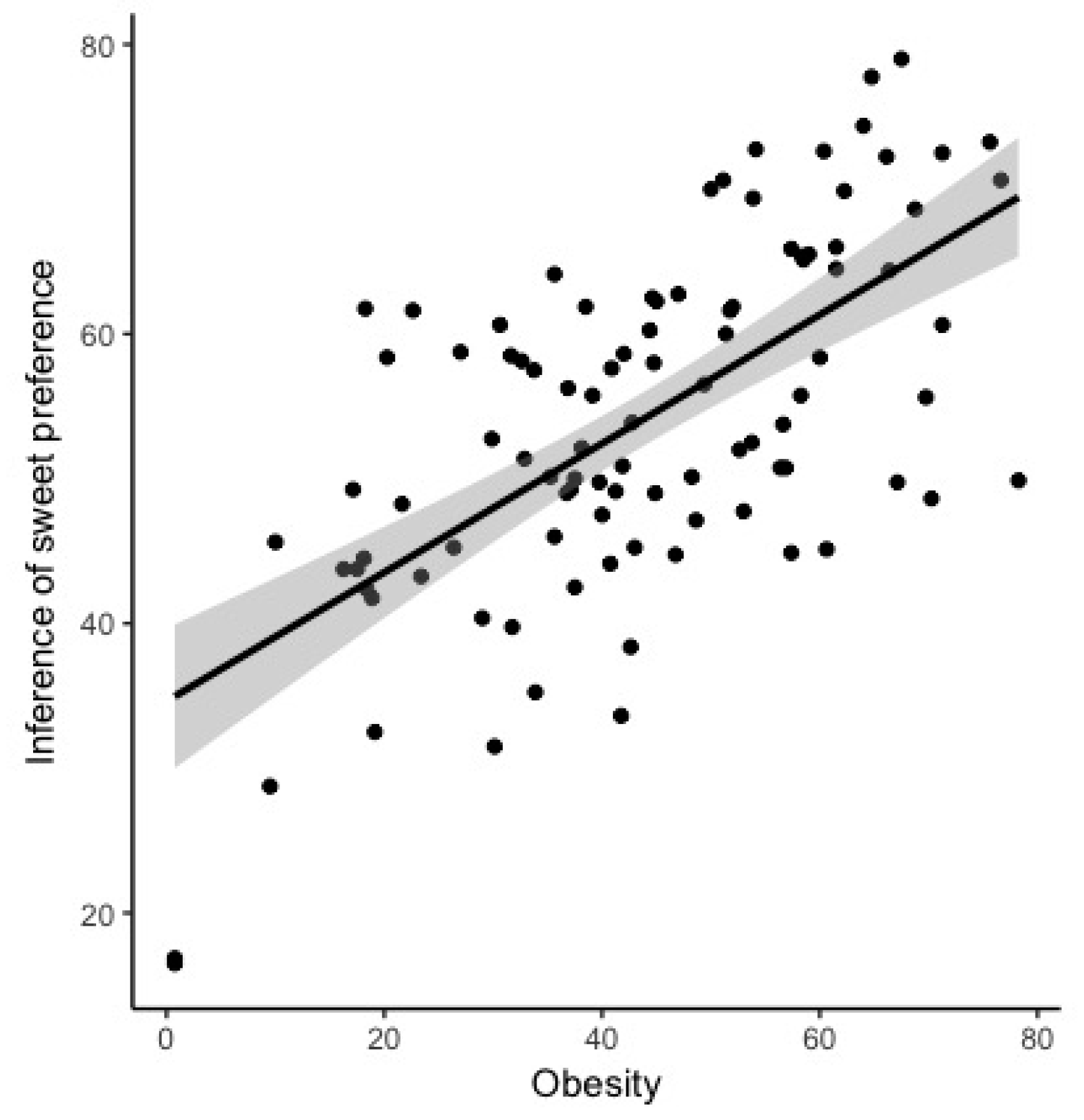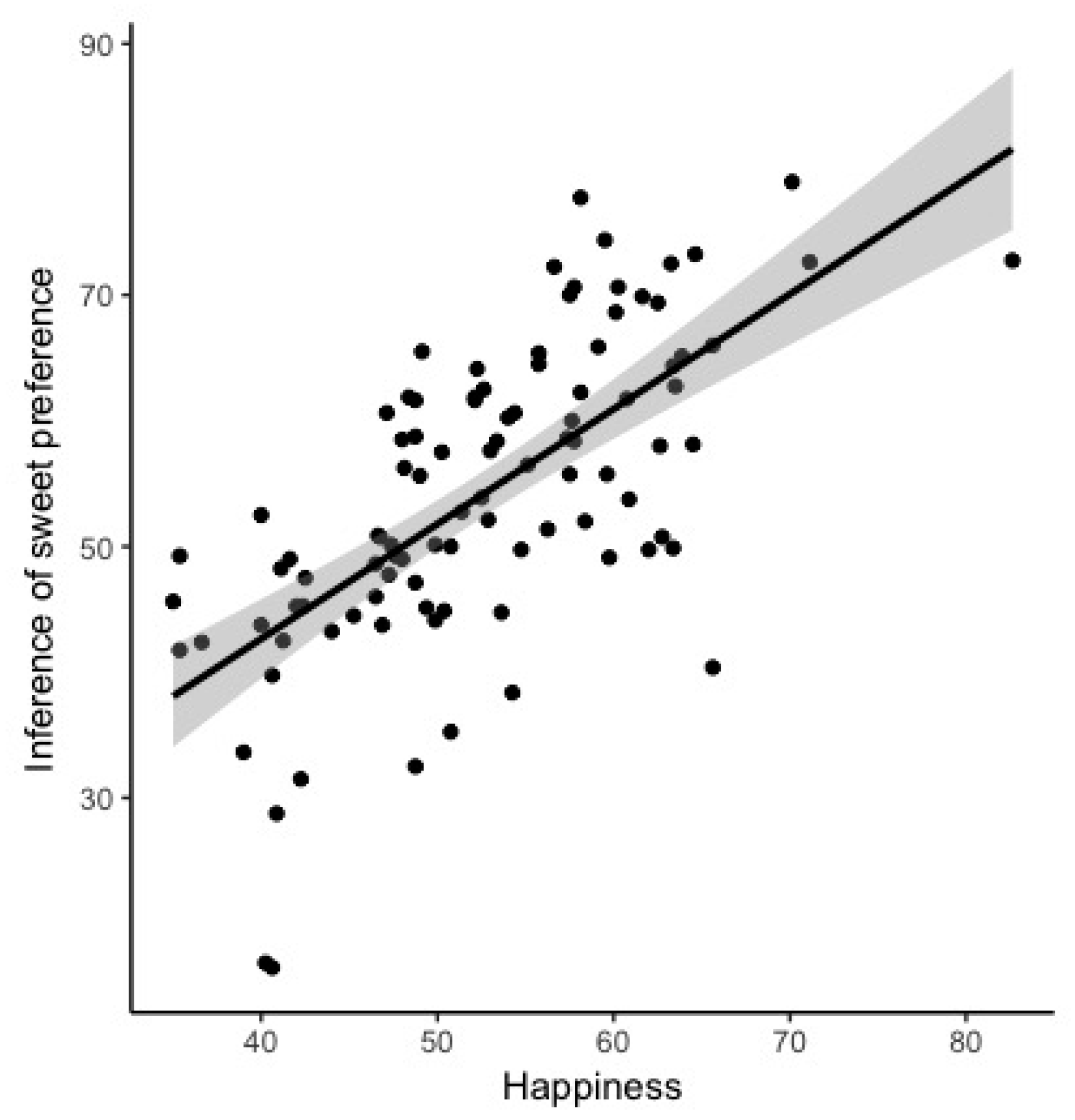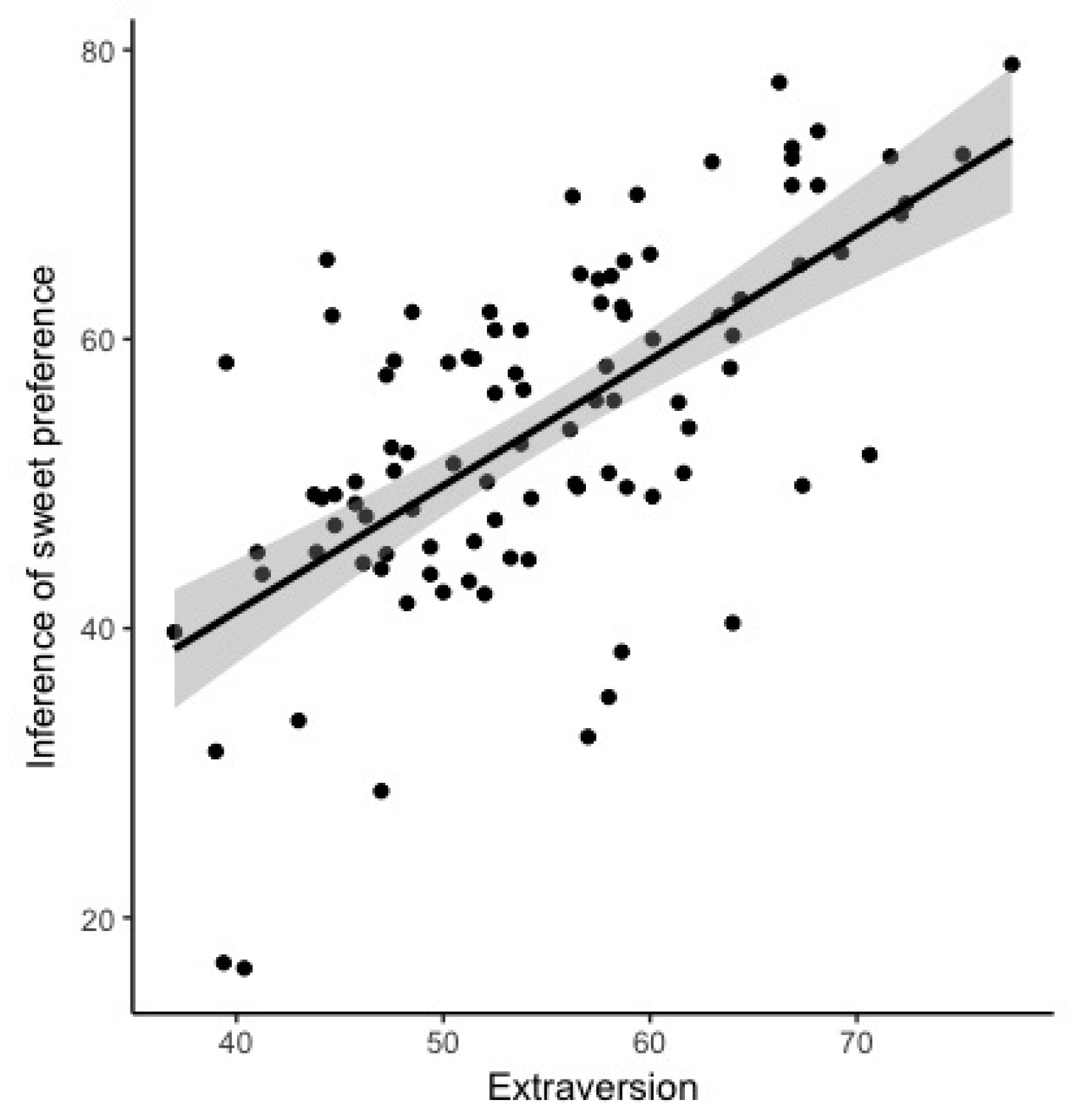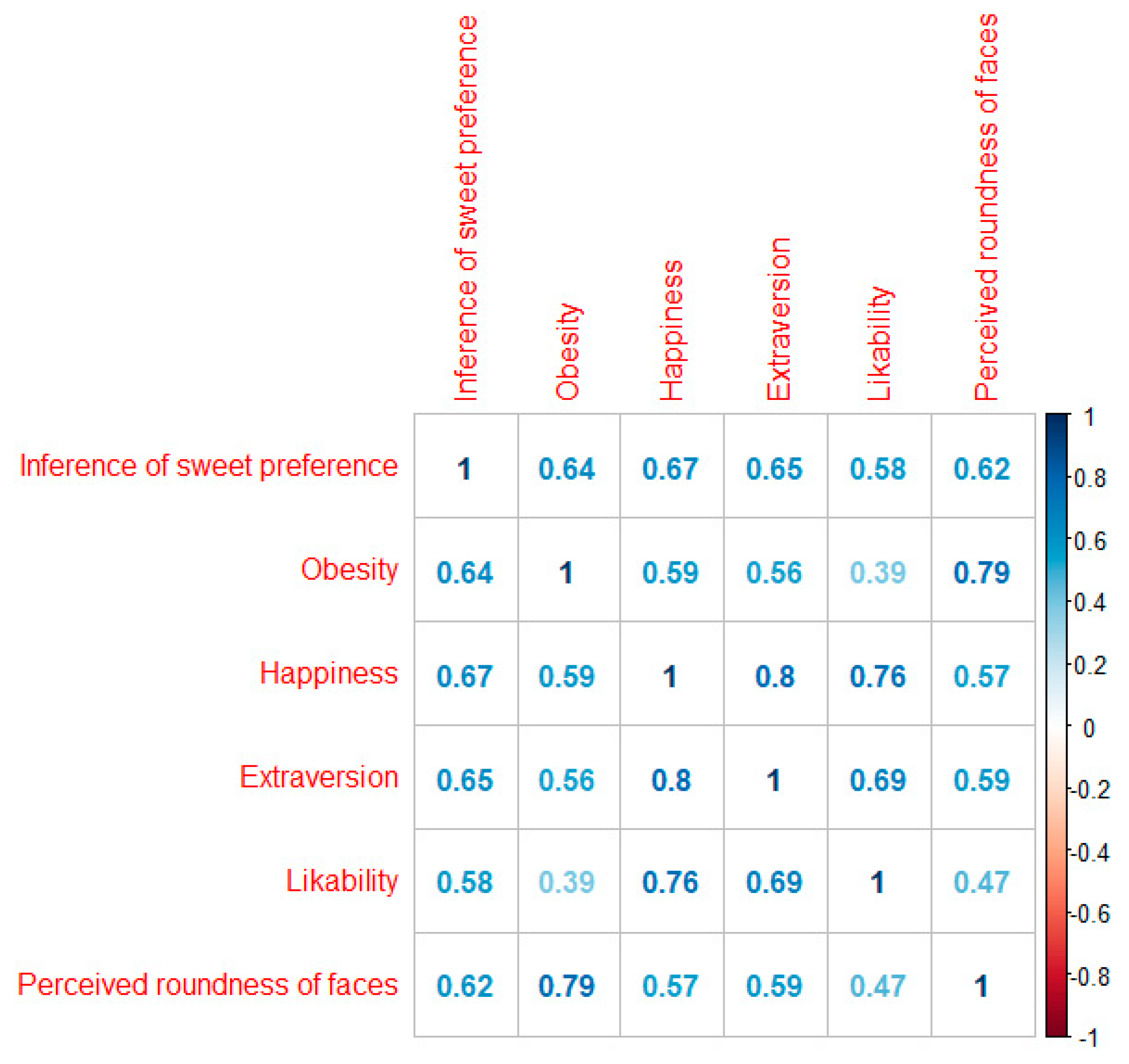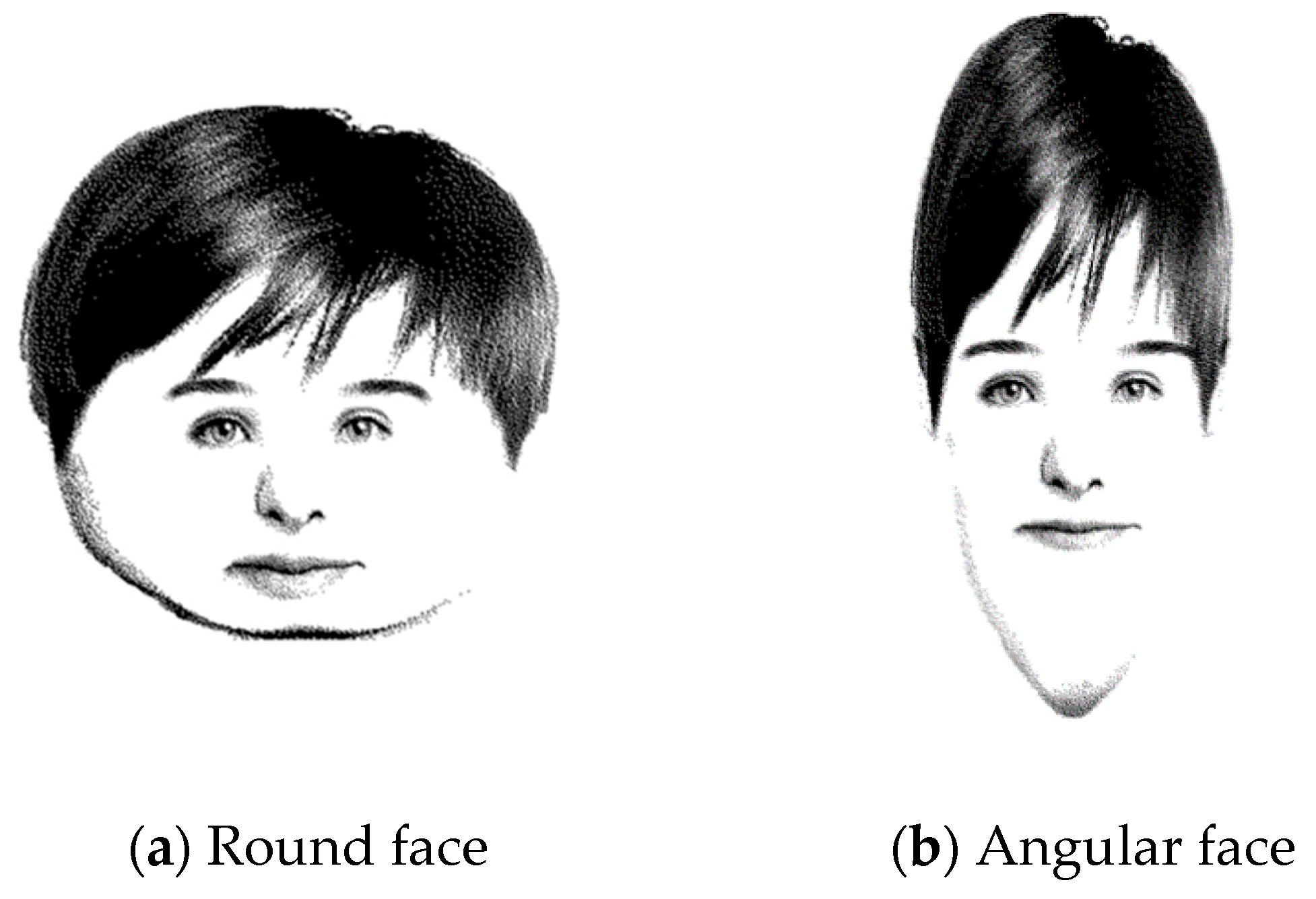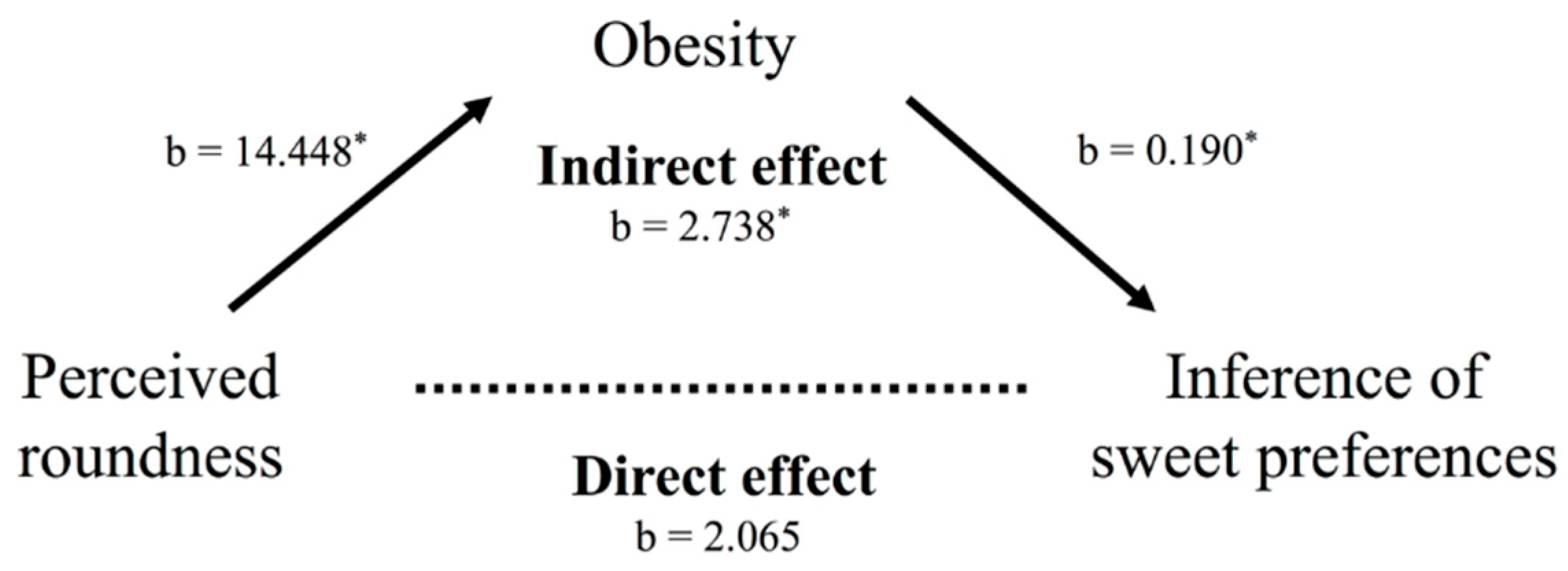1. Introduction
In retail settings, social perception of other peoples’ preferences is fundamental to successful interpersonal interactions. People often have opportunities to infer other peoples’ taste preferences during the process of product recommendation or gift-giving. Sales people may infer a consumer’s taste preferences when recommending food products. People give gifts of food to friends, family, or romantic partners by inferring the receiver’s taste on occasions such as anniversaries and annual events (birthdays, Christmas, or Valentine’s Day) [
1]. In addition, inference of food preferences may have evolved from an adaptive advantage borne of food sharing (i.e., an instance of reciprocal altruism) and may later have extended to the domain of mate selection [
2]. For example, we often infer taste preferences and prepare meals to share with others in a variety of situations (e.g., dating at restaurants, a dinner party with friends or guests). Together, inference of taste preferences forms a fundamental basis for retail and customer service settings. Although inference of others’ preferences is often erroneous and biased in the marketplace [
3], we do not yet know how inferences regarding taste preferences are made.
People make inferences about the attributes of individuals based on their faces. Although the face occupies a small area relative to the entire body, it plays a crucial role in social perception [
4]. People are capable of determining attributes, such as gender, ethnicity, and age, from faces [
4]. Additionally, people can accurately predict a variety of internal traits and characteristics, such as political attitudes [
5], sexual orientation [
6], the financial performance of CEOs [
7], and social class [
8], based on faces. As a result, faces provide a rich source of information about social attributes. However, we do not yet understand the complexities of how people infer preferences from faces.
The implied relationships between faces and social attributes are based on sensory associations. Interactions between different senses are called crossmodal correspondences [
9,
10,
11]. An example would be shape–sound correspondences. People reliably match certain sounds with certain visual characteristics, like roundness or sharpness. The arbitrary word “Bouba” tends to be assigned to round objects, whereas the word “Kiki” is likely to be associated with sharp objects [
12]. This association may be linked to the way mouth movements generate the words; pronouncing the word “Bouba” requires rounding in the mouth, whereas saying “Kiki” involves a “sharp” movement. Based on shape–sound correspondences, a previous study showed that facial roundness is matched with social attributes, such as names that are pronounced by rounding the mouth (e.g., Bob—round face, Nick—angular face) [
13]. Therefore, it is plausible that, like geometric shapes, people’s faces are likely to be matched with social attributes in line with crossmodal correspondence.
The term “social perception” can be defined as the initial stage of evaluating the intentions and psychological dispositions of others [
14]. Social perception can be conceptualized as part of mentalizing [
14], which is the perception of the dispositions and intentions of other individuals [
15]. Thus, the domain of social perception is implicated when a study includes human features (e.g., faces) and/or social judgments (e.g., inference about a person’s preferences) [
14,
16,
17]. However, it remains unknown whether correspondences between facial shapes and other senses (e.g., taste) influence inferences about other peoples’ preferences. This study investigated the role of facial shape and taste correspondence on social perceptions in the form of inferences about other peoples’ preferences.
Consistent with crossmodal correspondence, an inference about taste preference may be derived from facial roundness. The crossmodal correspondence literature suggests that people consistently match specific tastes to particular visual shapes [
18]. Sweet food is reliably matched with roundness, while sour food is significantly fitted with angularity [
19]. Thus, we hypothesized that people infer that round-faced (or angular-faced) people prefer sweet (or sour) foods.
An inference of another’s preference is likely to be derived from shape–taste correspondences. Crossmodal correspondences are defined as the perceived matching of different senses [
20], and shape–taste correspondences are also defined as matching of taste and shape [
18]. In addition, there are individual differences in how people perceive the match between roundness/angularity and sweet/sour [
18]. Thus, if an inference regarding another’s preference were based on a crossmodal correspondence framework, facial roundness and taste information should be matched, and the matching would mediate the inference of the other person’s preference. In other words, people who tend to perceive a match between round (or angular) and sweet (or sour) are more likely to infer that round- (or angular)-faced people prefer sweet (or sour) food.
We investigated whether facial shape–taste correspondence influenced inferences about other people’s preferences. Study 1 examined whether individuals with round (vs. angular) faces would be inferred to have sweet (vs. sour) preferences. To show that the preference inference was based on shape–taste correspondences, Study 2 tested whether facial roundness and taste information were well matched, and whether that matching mediated the inference about the other person’s preferences. Using more realistic facial stimuli, Study 3 investigated which physical and/or personality characteristics related to facial roundness mediated associations between facial roundness and taste information.
2. Study 1: Inference That Round-Faced People Prefer Sweet and Angular-Faced People Prefer Sour Tastes
Our first study examined whether individuals with round (vs. angular) faces would be assumed to prefer sweet (vs. sour) tastes.
2.1. Design
The study had a 2 (face: round, angular) × 2 (taste: sweet, sour) mixed-subject design, with face representing the between-subject and taste representing the within-subject factor. The main outcome was inferences about another person’s (taste) preference, which were made using a seven-point scale ranging from 1 = “Not at all” to 7 = “Very much”.
2.2. Participants
In total, 56 healthy participants (27 females, Mage = 21.1 years old (SD = 2.0)) were recruited using a bulletin-board posting and a student mailing list email. This study was approved by the ethics committee of the School of Medicine at Tohoku University and was conducted in accordance with the Declaration of Helsinki.
2.3. Task: Inference of Another Person’s Preference
Participants were randomly distributed into round (
n = 27, 12 females) and angular face (
n = 29, 15 females) groups. The round and angular faces were created using an online face generator (PimpTheFace), which was derived from a previous study that investigated correspondences between round/angular faces and sounds [
13]. The face generator allows users to create round/angular facial stimuli with almost the same arrangement of inner parts (eyes, mouth, nose), and prevents possible confounding effects derived from facial parts, facial expressions, or skin color.
Groups of two to four participants were placed in a room that accommodated a maximum of 10 people. Across groups, participants were shown a drawing of a face and asked to consider the preferences of the person shown (
Figure 1). Participants saw the face shown in
Figure 1. To prevent possible influence of the person’s characteristics unrelated to roundness, the characteristics attributed to the person (male, age 20, 170 cm in height, 60 kg in weight, university student) were the same across groups except for facial roundness. The participants were given these attributes before answering the following questions.
First, participants were asked to infer the preferences of each round- or angular-faced individual. The questions were: “How much do you think this person likes sweet foods?” and “How much do you think this person likes sour foods?”. Respondents provided their ratings for each question using a seven-point scale ranging from 1 = “Not at all” to 7 = “Very much”.
Then, participants were asked to answer two questions: “How much do you like this person?” and “How round/angular is this person’s face?” The participants rated liking and roundness based on the conditions allocated to them (the round face or the angular face). The participants replied with their rating for the liking question using a seven-point scale from 1 = “Not at all” to 7 = “Very much” and for the round/angular question using a seven-point scale from 1 = “Very angular” to 7 = “Very round”. Responses to these questions were used to confirm the similarity of the preferences according to the facial shape and to replicate the finding regarding the differences in the perceived roundness of round and angular faces. A total of four questions were presented to participants. The questions were presented in a paper format and the order of questions was not randomized. It took participants a few minutes to complete the questions.
2.4. Statistical Analysis
We applied analysis of variance (ANOVA) to assess the effects of facial shapes on inference of another person’s preference (sweetness, sourness). The design format was 2 (facial shape: round, angular) × 2 (tastes: sweet, sour), in which facial shapes functioned as the between-participants factor and taste as the within-participant factor. The inference of another person’s preference (“How much do you think this person likes sweet/sour foods?”), rated on a scale of 1–7, was the dependent variable used for ANOVA. The analyses were conducted using R ver. 3.3.1 and the R function “anovakun” ver. 4.8.0.
2.5. Results and Discussion
2.5.1. Inference of Another Person’s Preference
There was no main effect of facial shape (F1, 54 = 0.007, p = 0.932, η2p = 0.0001). However, the main effect of taste was significant (F1, 54 = 66.444, p < 0.001, η2p = 0.552), indicating that participants believed that more people preferred sweet than preferred sour tastes.
Notably, and consistent with our prediction, there was a significant interaction between face and taste (
F1, 54 = 42.590,
p < 0.001,
η2p = 0.441). A planned comparison showed that participants inferred that round-faced (vs. angular-faced) individuals preferred sweet foods (round-faced
sweet:
M = 5.724,
SD = 1.032 vs. angular-faced
sweet:
M = 4.222,
SD =1.311,
F1, 54 = 22.874,
p < 0.001,
η2p = 0.298), while angular-faced (vs. round-face) individuals preferred sour foods (angular-faced
sour:
M = 3.852,
SD = 1.200 vs. round-faced
sour:
M = 2.379,
SD = 0.622,
F1, 54 = 33.947,
p < 0.001,
η2p = 0.386). The results showed that participants inferred that round- (vs. angular) faced individuals preferred sweet foods (vs. sour foods). The results are shown in
Figure 2.
2.5.2. Liking and Perceive Roundness
Using a paired t-test, we compared preferences and perceived roundness between a round-faced person and an angular-faced person. There was no significant difference in preferences between a round-faced person and an angular-faced person (Mround = 3.172 vs. Mangular = 3.333; t54 = −0.419, p = 0.681). However, a round-faced person was perceived as having a rounder face than the angular-faced person (Mround = 6.483 vs. Mangular = 1.851; t54 = 16.907, p < 0.001).
3. Study 2: Facial Roundness and Taste Information Matching, and Matching as a Mediator for Inference of Preferences
Our second study examined whether facial roundness and taste information were well matched and whether the match modulated the inference of another person’s preferences. The methods were similar to Study 1 except for the additional questions (“How much do you think this person is associated with sweet/sour foods?”). Respondents provided their ratings for each question using a seven-point scale ranging from 1 = “Not at all” to 7 = “Very much”.
3.1. Participants
In total, 41 healthy participants (18 females, Mage = 21.4 years old, SD = 1.9) were recruited using a bulletin-board posting and a student mailing list email. This study was approved by the ethics committee of the School of Medicine at Tohoku University and was conducted in accordance with the Declaration of Helsinki. Participants were randomly distributed into round- (n = 21, 8 females) and angular- (n = 20, 10 females) faced groups.
3.2. Statistical Analysis
To assess facial shape effects on inference of another person’s taste preferences, we applied ANOVA. The design format was 2 (facial shape: round, angular) × 2 (tastes: sweet, sour), in which facial shapes functioned as the between-participants factor and taste as the within-participant factor. The inference of another person’s preference was the dependent variable for ANOVA.
To assess facial shape effects on perceived matching with tastes, we applied ANOVA. The design format was 2 (facial shape: round, angular) × 2 (tastes: sweet, sour), in which facial shapes functioned as the between-participants factor and taste as the within-participant factors. We used perceived matching (“How much do you think this person is associated with sweet/sour foods?”), rated on a scale of 1–7, as the dependent variable for ANOVA.
To ascertain whether perceived matching mediated the relation between facial shape and inferences of sweet/sour preference, we conducted mediation analysis using the PROCESS macro for SPSS [
21] and performed bootstrapping analyses using 5000 bootstrap samples [
22]. Entering face shapes (roundness = 1, angularity = 0) as the independent variable (X), sweet preference as the outcome variable (Y), and perceived matching between shape and sweet food as the mediator variable (
M), we estimated indirect effects using unstandardized regression coefficients. The Sobel test was used to evaluate the significance of indirect effects based on a normal theory approach [
23].
3.3. Results and Discussion
3.3.1. Inference of Other Peoples’ Preferences
There was no main effect of facial shape (F1, 39 = 1.797, p = 0.188, η2p = 0.044). However, the main effect of taste was significant (F1, 39 = 22.215, p < 0.001, η2p = 0.363), showing that participants inferred that more people preferred sweet tastes than sour ones.
Results replicated those of Study 1, showing a significant interaction between face shape and taste (
F1, 39 = 7.217,
p = 0.011,
η2p = 0.156). Planned comparisons showed that participants inferred that a round-faced (vs. angular-faced) person preferred sweet foods (round-faced
sweet:
M = 5.381,
SD = 1.466 vs. angular-faced
sweet:
M = 4.200,
SD = 1.436,
F1, 39 = 6.782,
p = 0.013,
η2p = 0.148), while an angular-faced (vs. round-faced) person preferred sour foods (angular-faced
sour:
M = 3.600,
SD = 1.353 vs. round-faced
sour:
M = 3.190,
SD = 0.981,
F1, 39 = 1.240,
p = 0.272,
η2p = 0.031). The results are shown in
Figure 3.
3.3.2. Matching Facial Roundness to Taste Information
There was no main effect of facial shape, F1, 39 = 1.976, p = 0.168, η2p = 0.048. However, the main effect of taste was significant (F1, 39 = 19.409, p < 0.001, η2p = 0.332). Such that participants perceived that people generally prefer sweet tastes over sour ones.
There was a significant interaction between face shape and taste (F1, 39 = 10.939, p = 0.002, η2p = 0.219). A planned comparison showed that a round-faced (vs. angular-faced) person was more frequently matched with sweet foods (round-faced sweet: M = 5.191, SD = 1.537 vs. angular-facedsweet: M = 3.600, SD =1.667, F1, 39 = 10.102, p = 0.003, η2p = 0.206), while the match between an angular-faced person (vs. round-faced person) and sour foods was marginally significant (angular-facedsour: M = 3.200, SD =1.642 vs. round-facedsour: M = 2.380, SD = 0.865, F1, 39 = 4.051, p = 0.051, η2p = 0.094).
3.3.3. Perceived Matching as a Mediator
To examine whether perceived matching mediated the relationship between facial shape and inferences of sweet/sour preference, we conducted a mediational analysis. We modeled the indirect effect of facial shape on inferences about round-faced people’s preferences as mediated by perceived matching.
Supporting the prediction, the bootstrap estimates were positive, and the 95% bias-corrected confidence intervals did not include zero. The total indirect effect was 0.761,
SE = 0.206,
CI (0.302, 1.266). The significance of the indirect effect was confirmed by the Sobel test (
z = 2.992,
p = 0.004) (
Figure 4).
3.3.4. Preference and Perceived Roundness
Using a paired t-test, we compared the preferences and perceived roundness of round-faced and angular-faced persons. There was no significant difference in preferences between the round-faced and angular-faced persons (Mround = 3.810 vs. Mangular = 3.300; t39 = 1.065, p = 0.293). However, the round-faced person was perceived as having a rounder face than the angular-faced person (Mround = 6.476 vs. Mangular = 1.950; t39 = 12.770, p < 0.001).
4. Study 3: Facial Roundness and Taste Information Matching Based on More Realistic Faces, and the Physical and/or Personality Characteristics Related to Facial Roundness as Mediators for Inference of Preferences
In a third study, we aimed to (1) detect the mediator of facial roundness and inference of other’s sweet preference and (2) increase the reliability of our findings. Although Study 2 showed that perceived matching mediated sensory associations, the mechanism underlying the perceived matching remains elusive. One possible explanation why people form impressions based on facial roundness–taste correspondences may pertain to the physical and/or personality characteristics related to facial roundness (obesity, happiness, extraversion) (e.g., [
24]). People may expect round-faced people to be more obese, happy, likable, and extraverted, leading to inferences about preferences biased toward sweet foods. To investigate this possibility, we asked participants to rate the perceived obesity, happiness, likability, and extraversion of each face. Furthermore, to ensure that our findings in Studies 1–2 were not stimuli-specific (two cartoon faces with extremely round and extremely angular faces were used), we tried to replicate our findings using a variety of more realistic facial stimuli (24 faces with moderately round, neutral, and moderately angular faces). Moreover, we added the other taste preferences (saltiness, bitterness) to confirm the specificity of the associations between facial roundness and inferences about taste preferences.
4.1. Design
The study had a 3 (face: round, angular, neutral) × 4 (taste: sweet, sour, salty, bitter) within-subject design, treating both face and taste as within-subject factors. The main outcome was the inference of (taste) preference.
4.2. Participants
In total, 33 healthy participants (17 females,
Mage = 36.8 years old,
SD = 9.2) were recruited through Lancers and completed the survey on Qualtrics. The sample size was determined using G*power software [
25]. We entered the medium effect size (f = 0.25), alpha level (a = 0.05/4, because we have four measures, sweet, sour, salty, and bitter, in Study 3), and power (1-b = 0.80) into G*Power. The required sample size was 30; we used a sample size of 33. The populations differed from those in Study 1 and 2, to increase the generalizability of our findings. This study was approved by the Ethics Committee of the School of Medicine at Tohoku University and was conducted in accordance with the Declaration of Helsinki.
4.3. Task: Inference of Another Person’s Preference
Following previous studies [
26,
27] (FaceGen Modeller 3.14), we created the round, angular, and neutral faces using a realistic 3D human face generator. Initially, we randomly generated four male and four female faces (Asian) for the neutral conditions. Using FaceGen Modeller, we changed the cheeks (round/gaunt) parameter for the round faces (the parameter = −0.5), neutral faces (the parameter = 0), and angular faces (the parameter = +0.5). FaceGen Modeller allows users to create round/angular facial stimuli with an almost identical arrangement of inner features (eyes, mouth, nose) and prevents possible confounding effects derived from facial parts, facial expressions, or skin color. We used 24 stimuli (four males and four females ranging from round-faced to neutral to angular-faced). Examples of stimuli used in Study 3 are shown in
Figure 5.
First, participants were asked to infer the taste preferences (sweet, sour, salty, and bitter) of the facial images: “How much do you think this person likes sweet foods?”, “How much do you think this person likes sour foods?”, “How much do you think this person likes salty foods?”, and “How much do you think this person likes bitter foods?” Respondents provided their ratings for each question using a visual analogue scale (VAS) ranging from 0 = “Not at all” to 100 = “Very much”. The order of questions was randomized.
Next, participants were asked to rate the obesity, happiness, extraversion, and likability of the individuals: “How obese is this person?”, “How happy is this person?”, “How extraverted is this person?”, and “How much do you like this person?” using a VAS scale ranging from 0 = “not at all” to 100 = “very much”. The order of the four questions was randomized. Finally, participants were asked to rate the roundness/angularity of each face (“How round/angular is this person’s face?”) on a VAS scale ranging from 0 = “very angular” to 100 = “very round”.
4.4. Statistical Analysis
To assess facial shape effects on inference of another person’s taste preferences, we applied ANOVA. The design format was 3 (facial shape: round, angular, neutral) × 2 (tastes: sweet, sour, salty, bitter), in which facial shapes and taste as the within-participant factor. Inference of another person’s preferences was the dependent variable for ANOVA. For cases in which a significant interaction was found, we conducted post-hoc analyses to evaluate the interaction. Post-hoc analyses were conducted using Shaffer’s modified sequentially rejective Bonferroni test procedure. The analyses were conducted using R ver. 3.3.1 and the R function “anovakun” ver. 4.8.0.
To ascertain details of the effects of facial shapes on the inference of another person’s taste preferences, we conducted regression analyses. First, to test the relations between facial roundness and taste, we performed single regression analyses using inferences about preferences for respective tastes (sweet, sour, salty, bitter) as predictors and perceived roundness (rated on a VAS from very angular = 0 to very round = 100) as explanatory variables. The analysis was restricted to those tastes for which significance was found using ANOVA analysis.
Second, to test the relations between the inference of another person’s taste preferences and physical or personality characteristics related to facial roundness (obesity, happiness, extraversion, and likability), we conducted single regression analyses using inferences about preferences for respective tastes as predictors and physical or personality characteristics related to facial roundness (obesity, happiness, extraversion, and likability) as explanatory variables.
Next, we ran multiple regression analysis to search for variables influencing inferences about taste preferences by including perceived roundness and physical or personality characteristics related to facial roundness in the model. We used inferences about taste preferences as predictors, perceived roundness as an explanatory variable, and physical or personality characteristics related to facial roundness (obesity, happiness, extraversion, and likability) as control variables. Regression analyses were conducted using R ver. 3.3.1 and the R function “lmres”.
To assess whether physical or personality characteristics related to facial roundness (obesity, happiness, extraversion, and likability) mediate the relation between facial shape and inferences of taste preferences, we conducted our mediation analysis using the PROCESS macro for SPSS [
21] with 5000 bootstrap samples [
22]. Entering perceived roundness as the independent variable (X), inferences of taste preferences as the outcome variable (Y), and the physical or personality characteristics related to facial roundness (obesity, happiness, extraversion, and likability) as the mediator variable (
M) or control variables, we estimated indirect effects using unstandardized regression coefficients. The Sobel test was applied to assess the significance of indirect effects based on a normal theory approach [
23]. All tests were two-tailed. Statistical significance was inferred for
p < 0.05.
4.5. Results and Discussion
4.5.1. Inferences about Preferences
There was no main effect of facial shape (F2, 64 = 1.801, p = 0.173, η2p = 0.053). However, the main effect of taste was significant (F3, 96 = 17.637, p < 0.001, η2p = 0.355), indicating that participants inferred that people prefer certain tastes over others. Pairwise analyses showed that people inferred that sweet foods (M = 54.117, SD = 12.132) were more strongly preferred than bitter foods (M = 46.934, SD = 11.058, t32 = 3.594, adj.p = 0.003). There were no differences between sweet foods and sour foods (M = 52.230, SD = 11.102, t32 = 1.116, adj.p = 0.273). People inferred that salty foods (M = 62.408, SD = 11.071) were more strongly preferred than sweet foods (t32 = 3.884, adj.p = 0.002), sour foods (t32 = 4.072, adj.p < 0.001), and bitter foods (t32 = 5.627, adj.p < 0.001). People inferred that sour foods were more strongly preferred than bitter foods (t32 = 3.141, adj.p = 0.007).
Importantly, these results replicated those of Studies 1–2 and reflected a significant interaction between face shape and taste (
F6, 192 = 29.993,
p < 0.001,
η2p = 0.484). Post hoc analyses showed the simple effects of the interaction between face shape and taste (
Figure 6). Different facial shapes differentially influenced inferences about preferences for sweet (
F2, 64 = 44.372,
p < 0.001,
η2p = 0.581), sour (
F2, 64 = 9.018,
p < 0.001,
η2p = 0.220), and bitter (
F2, 64 = 11.772,
p < 0.001,
η2p = 0.269) foods, but it did not have a significant effect on preferences for salty foods (
F2, 64 = 0.053,
p = 0.949,
η2p = 0.002).
Planned comparisons showed that participants inferred that round-faced people (
M = 62.511,
SD = 9.801) preferred sweet foods more strongly than did angular-faced (
M = 54.981,
SD = 7.955,
t32 = 7.215,
adj.p < 0.001) and neutral-faced (
M = 44.860,
SD = 11.384,
t32 = 6.236,
adj.p < 0.001) people. They also inferred that neutral-faced people preferred sweet foods more strongly than did angular-faced people (
t32 = 5.339,
adj.p < 0.001). The results are shown in
Figure 6.
Participants inferred that angular-faced people (M = 54.599, SD = 11.874) preferred sour foods more strongly than round-faced people did (M = 49.572, SD = 10.782, t32 = 3.950, adj.p = 0.001). They also inferred that neutral-faced people (M = 52.512, SD = 10.349) preferred sour foods more strongly than did round-faced people (t32 = 2.732, adj.p = 0.010). The differences between angular- and neutral-faced people were not significant (t32 = 1.720, adj.p < 0.095).
Participants inferred that angular-faced people (M = 50.379, SD = 11.457) preferred bitter foods more strongly than did round-faced (M = 43.599, SD = 10.696, t32 = 4.920, adj.p = 0.001) and neutral-faced (M = 46.826, SD = 10.252, t32 = 2.508, adj.p = 0.017) people. They also inferred that neutral-faced people preferred bitter foods more strongly than did round-faced people (t32 = 2.308, adj.p = 0.028).
4.5.2. Predicting Inferences about Taste Preference from Facial Roundness
Perceived facial roundness significantly explained inferences about sweet (β = 0.552,
SE = 0.0716,
t = 7.719,
p < 0.001;
Figure 7) and salty (β = −0.239,
SE = 0.079,
t = −3.012,
p = 0.003) preferences but not sour (β = −0.155,
SE =0.082,
t = −1.900,
p = 0.060) or bitter (β = 0.087,
SE = 0.083,
t = 1.049,
p = 0.297) preferences.
4.5.3. Predicting Inferences about Taste Preference from Physical and/or Personality Characteristics Related to Facial Roundness
All of the variables (obesity, happiness, extraversion, and likability) significantly explained inferences about sweetness preference (obesity: β = 0.642,
SE = 0.078,
t = 8.254,
p < 0.001; happiness: β = 0.666,
SE = 0.076,
t = 8.799,
p < 0.001; extraversion: β = 0.649,
SE = 0.077,
t = 8.394,
p < 0.001; likability: β = 0.583,
SE = 0.083,
t = 7.061,
p = 0.297). The scatterplots are shown in
Appendix A Figure A1,
Figure A2,
Figure A3 and
Figure A4.
4.5.4. Predicting Inferences about Sweet Preference from Facial Roundness after Controlling for Physical and/or Personality Characteristics Related to Facial Roundness
After controlling physical and/or personality characteristics related to facial roundness (obesity, happiness, extraversion, and likability), perceived roundness did not independently contribute to inferences about sweet preferences (β = 0.262, SE = 0.1102, t = 2.378, p = 0.019). Happiness, extraversion, and likability did not contribute to inferences about sweet preferences (happiness: β = 0.262, SE = 0.1102, t = 2.378, p = 0.019; extraversion: β = 0.262, SE = 0.1102, t = 2.378, p = 0.019; likability: β = 0.262, SE = 0.1102, t = 2.378, p = 0.019). Only obesity was significantly related to inferences about sweet preferences (β = 0.262, SE = 0.1102, t = 2.378, p = 0.019).
4.5.5. Obesity as a Mediator
To examine whether obesity mediates the relationship between facial shape and inferences of sweet/sour preferences, we carried out a mediational analysis. We modeled the indirect effect of facial shape on inferences about round-faced people’s sweet preferences, as mediated by obesity after controlling for happiness, extraversion, and likability.
Supporting the prediction, the bootstrap estimates were positive, and the 95% bias-corrected confidence intervals did not include zero. The total indirect effect was 2.738,
SE = 1.234,
CI (0.103, 5.488). The significance of the indirect effect was confirmed by the Sobel test (
z = 2.201,
p = 0.023) (
Figure 8). A correlation matrix of all variables is shown in
Appendix A Figure A5.
